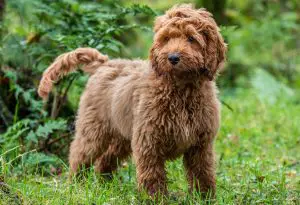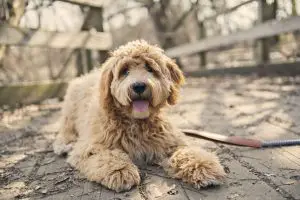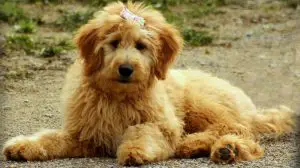Have you ever wondered about How Fast Does A Dog’s Hair Grow? It’s a question that often crosses the minds of pet owners who are curious about the grooming needs of their furry companions. The speed at which a dog’s hair grows can vary depending on factors such as breed, age, and overall health.
Understanding this growth process is essential for maintaining your dog’s coat and ensuring their well-being. In this exploration, we’ll delve into the intriguing world of canine hair growth, shedding light on the factors influencing it and providing insights into how you can best care for your beloved pet’s coat.
How Fast Does A Dog’s Hair Grow

The rate at which a dog’s hair grows can vary based on factors such as breed, age, health, and individual genetics. On average, dogs’ hair grows at a rate of about 1 to 1.5 inches (2.5 to 3.8 cm) per month. However, some breeds are known for faster or slower hair growth.
Breeds with continuously growing hair, such as Poodles, Maltese, and Yorkshire Terriers, may require regular grooming to prevent their hair from becoming too long and matted. Other breeds with shorter hair or shedding coats may not need as frequent grooming.
It’s important to note that individual variations exist, and factors like nutrition, overall health, and environmental conditions can influence the rate of hair growth in dogs. If you have concerns about your dog’s coat or grooming needs, it’s advisable to consult with a veterinarian or a professional groomer for guidance tailored to your specific dog’s breed and health.
What factors influence the speed of a dog’s hair growth?
Several factors can influence the speed of a dog’s hair growth. Here are some key factors:
- Breed: Different dog breeds have different coat types and growth rates. Breeds with continuously growing hair, such as Poodles, Shih Tzus, and Afghan Hounds, may have a faster apparent hair growth rate compared to breeds with shorter or seasonal shedding coats.
- Genetics: Individual genetics play a significant role in determining the characteristics of a dog’s coat, including the rate of hair growth. Dogs from the same litter may have varying coat lengths and growth rates.
- Health: The overall health of a dog can impact its coat condition and growth. A well-balanced diet with proper nutrition is essential for maintaining healthy skin and coat. Skin conditions, hormonal imbalances, and other health issues can affect the rate of hair growth.
- Age: Puppies often have a different coat texture than adult dogs, and the rate of hair growth can vary during different life stages. In general, puppies may experience more rapid hair growth than adult dogs.
- Hormones: Hormonal changes, such as those associated with puberty, pregnancy, and aging, can affect a dog’s coat and hair growth. Female dogs may experience changes in their coat during estrus (heat) cycles.
- Grooming Practices: Regular grooming can influence the appearance and perceived growth rate of a dog’s coat. Regular brushing helps distribute natural oils, prevents matting, and promotes a healthy coat. Grooming practices, including the use of specific shampoos and conditioners, can also impact coat health.
- Environmental Factors: The environment in which a dog lives can affect its coat. Exposure to sunlight, temperature, and humidity levels can influence the condition and growth of the hair.
These factors above interact, and a combination of genetics, health, and environmental influences contributes to the overall appearance and growth of a dog’s coat. If you have concerns about your dog’s coat or hair growth, consulting with a veterinarian can help identify any underlying health issues or specific care needs for your dog’s breed.
Is there a specific rate at which a dog’s hair grows?
The rate at which a dog’s hair grows can vary depending on factors such as the dog’s breed, age, health, and individual genetics. On average, most dogs’ hair grows at a rate of about half an inch (1.25 cm) per month. However, this can be faster or slower in different breeds.
Some dog breeds are known for their rapid hair growth, while others have slower growth rates. For example, breeds like the Poodle, Shih Tzu, and Maltese often have continuously growing hair that requires regular grooming. Breeds with shorter hair, such as Beagles or Boxers, may not require as frequent grooming.
Additionally, factors like diet, overall health, and hormonal changes can influence the rate of hair growth in dogs. Puppies usually have faster hair growth than older dogs, and the growth rate may also slow down in senior dogs.
If you have concerns about your dog’s hair growth or notice any changes, it’s a good idea to consult with a veterinarian. They can provide guidance on grooming needs, nutrition, and whether there might be any underlying health issues affecting your dog’s coat.
Do different dog breeds have varying hair growth rates?

Yes, different dog breeds do have varying hair growth rates. The growth rate of a dog’s hair is influenced by genetic factors, and different breeds have been selectively bred for specific coat types. Here are some general observations about hair growth rates in different types of dog coats:
- Continuous Growth Coats: Breeds with continuously growing hair, such as Poodles, Shih Tzus, Maltese, and Afghan Hounds, often have a faster hair growth rate. These breeds may require regular grooming and haircuts to prevent their coats from becoming tangled or matting.
- Double Coats: Breeds with double coats, like the Siberian Husky, German Shepherd, and Samoyed, typically shed their undercoat seasonally. While the outer guard hairs may have a relatively steady growth rate, the undercoat shedding can affect the overall appearance of the coat.
- Short-Haired Breeds: Breeds with short coats, such as Beagles, Boxers, and Dachshunds, generally have a slower hair growth rate. While they may not require as much grooming as long-haired breeds, regular brushing can still help maintain a healthy coat.
- Hairless Breeds: Some breeds, like the Chinese Crested and the Peruvian Inca Orchid, are known for being partially or completely hairless. In these breeds, hair growth may be minimal or absent, and grooming needs are different compared to breeds with full coats.
Factors such as age, overall health, and diet can impact the quality and growth of a dog’s coat. If you have specific concerns about your dog’s coat or grooming needs, it’s recommended to consult with a veterinarian or a professional groomer who can provide guidance based on your dog’s breed and individual characteristics.
What role does nutrition play in a dog’s hair growth speed?
Nutrition plays a crucial role in a dog’s overall health, including the health of their skin and coat. A well-balanced and nutritionally complete diet is essential for supporting optimal hair growth and maintaining a shiny, healthy coat. Here are some key nutrients that play a role in promoting good coat health and hair growth in dogs:
- Protein: Protein is a fundamental building block for hair. It contains amino acids, which are essential for the growth and maintenance of skin and coat. Diets rich in high-quality animal-based protein sources, such as meat, fish, and eggs, contribute to healthy hair growth.
- Omega-3 Fatty Acids: Omega-3 fatty acids, found in fish oil and certain plant sources, have anti-inflammatory properties and can help maintain a healthy skin and coat. They are particularly beneficial for dogs with dry or itchy skin.
- Omega-6 Fatty Acids: These fatty acids, found in oils like sunflower oil and safflower oil, are important for maintaining the skin barrier and preventing excessive water loss from the skin. They also contribute to a shiny coat.
- Vitamins A and E: These vitamins are essential for skin health. Vitamin A is important for the growth of skin cells, while vitamin E acts as an antioxidant that helps protect the skin and hair follicles from damage.
- Biotin: Biotin, a B-vitamin, is often associated with promoting healthy skin and coat. While biotin deficiencies are rare, ensuring an adequate amount in the diet may be beneficial for coat health.
- Zinc: Zinc is a mineral that plays a role in skin health and hair growth. A deficiency in zinc can lead to coat abnormalities and skin issues.
It’s important to provide a well-balanced and species-appropriate diet for your dog’s specific needs. If you have concerns about your dog’s coat or overall health, it’s advisable to consult with a veterinarian.
They can assess your dog’s individual nutritional requirements and recommend an appropriate diet or supplements if necessary. Additionally, addressing any underlying health issues or allergies can also positively impact the condition of your dog’s coat.

Does grooming affect the rate of a dog’s hair growth?
Grooming itself does not directly affect the rate of a dog’s hair growth. The growth rate of a dog’s hair is primarily determined by genetic factors, breed characteristics, age, health, and overall nutrition. However, grooming practices can influence the appearance, health, and manageability of a dog’s coat.
Here’s how grooming can impact a dog’s coat:
- Removal of Dead Hair: Regular grooming, including brushing, helps remove loose and dead hair from a dog’s coat. This can prevent matting, reduce shedding, and improve the overall health of the coat. While it doesn’t affect the rate of new hair growth, it can make the existing coat look healthier and more vibrant.
- Stimulating Hair Follicles: Brushing and massaging the skin during grooming can stimulate blood flow to the hair follicles. While this doesn’t directly increase the rate of hair growth, improved blood circulation can contribute to healthier hair follicles and a shinier coat.
- Preventing Matting and Tangles: Regular grooming, especially for breeds with longer or continuously growing hair, helps prevent matting and tangles. Mats and tangles can lead to discomfort for the dog and may require shaving or cutting the hair, impacting the appearance of the coat.
- Trimming and Haircuts: Trimming or cutting a dog’s hair can give the appearance of faster growth, especially in breeds with continuously growing hair. However, this is an illusion, as the rate of hair growth remains the same. Regular haircuts are often necessary to maintain a specific length and style, depending on the breed and owner’s preference.
- Skin and Coat Health: Proper grooming practices, including regular bathing and cleaning, contribute to overall skin and coat health. A healthy skin environment supports optimal hair growth and minimizes issues such as dryness or flakiness.
While grooming is essential for the well-being of a dog’s coat, it’s important not to over-groom. Excessive bathing or brushing can strip natural oils from the skin, leading to dryness and potential skin issues.
The frequency and type of grooming needed depend on the dog’s breed, coat type, and individual characteristics. Consulting with a professional groomer or your veterinarian can help establish a grooming routine that suits your dog’s specific needs.
Conclusion
This page reveals all you need to know on How Fast Does A Dog’s Hair Grow. The rate at which a dog’s hair grows varies based on factors like breed, genetics, age, health, and nutrition.
On average, dogs’ hair grows at a rate of about half an inch per month. Different breeds have different growth rates, with continuously growing coat breeds requiring more frequent grooming. While grooming practices can enhance coat health and appearance, they don’t directly affect the speed of hair growth.
Providing a balanced diet rich in essential nutrients is crucial for supporting optimal coat health and promoting normal hair growth in dogs. Regular veterinary check-ups can help address any concerns related to a dog’s coat and overall well-being.


